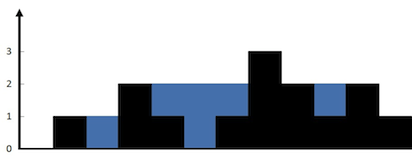C++收集雨水问题怎么解决
导读:本文共3040字符,通常情况下阅读需要10分钟。同时您也可以点击右侧朗读,来听本文内容。按键盘←(左) →(右) 方向键可以翻页。
摘要:这篇“C++收集雨水问题怎么解决”文章的知识点大部分人都不太理解,所以小编给大家总结了以下内容,内容详细,步骤清晰,具有一定的借鉴价值,希望大家阅读完这篇文章能有所收获,下面我们一起来看看这篇“C++收集雨水问题怎么解决”文章吧。收集雨水Givennnon-negative integers representing an elevation map where the width of each... ...
目录
(为您整理了一些要点),点击可以直达。这篇“C++收集雨水问题怎么解决”文章的知识点大部分人都不太理解,所以小编给大家总结了以下内容,内容详细,步骤清晰,具有一定的借鉴价值,希望大家阅读完这篇文章能有所收获,下面我们一起来看看这篇“C++收集雨水问题怎么解决”文章吧。
收集雨水
Givennnon-negative integers representing an elevation map where the width of each bar is 1, compute how much water it is able to trap after raining.

The above elevation map is represented by array [0,1,0,2,1,0,1,3,2,1,2,1]. In this case, 6 units of rain water (blue section) are being trapped.Thanks Marcosfor contributing this image!
Example:
Input: [0,1,0,2,1,0,1,3,2,1,2,1]
Output: 6
这道收集雨水的题跟之前的那道Largest Rectangle in Histogram有些类似,但是又不太一样,先来看一种方法,这种方法是基于动态规划 Dynamic Programming 的,维护一个一维的 dp 数组,这个 DP 算法需要遍历两遍数组,第一遍在 dp[i] 中存入i位置左边的最大值,然后开始第二遍遍历数组,第二次遍历时找右边最大值,然后和左边最大值比较取其中的较小值,然后跟当前值 A[i] 相比,如果大于当前值,则将差值存入结果,参见代码如下:
C++ 解法一:
classSolution{public:inttrap(vector<int>&height){intres=0,mx=0,n=height.size();vector<int>dp(n,0);for(inti=0;i<n;++i){dp[i]=mx;mx=max(mx,height[i]);}mx=0;for(inti=n-1;i>=0;--i){dp[i]=min(dp[i],mx);mx=max(mx,height[i]);if(dp[i]>height[i])res+=dp[i]-height[i];}returnres;}};Java 解法一:
publicclassSolution{publicinttrap(int[]height){intres=0,mx=0,n=height.length;int[]dp=newint[n];for(inti=0;i<n;++i){dp[i]=mx;mx=Math.max(mx,height[i]);}mx=0;for(inti=n-1;i>=0;--i){dp[i]=Math.min(dp[i],mx);mx=Math.max(mx,height[i]);if(dp[i]-height[i]>0)res+=dp[i]-height[i];}returnres;}}再看一种只需要遍历一次即可的解法,这个算法需要 left 和 right 两个指针分别指向数组的首尾位置,从两边向中间扫描,在当前两指针确定的范围内,先比较两头找出较小值,如果较小值是 left 指向的值,则从左向右扫描,如果较小值是 right 指向的值,则从右向左扫描,若遇到的值比当较小值小,则将差值存入结果,如遇到的值大,则重新确定新的窗口范围,以此类推直至 left 和 right 指针重合,参见代码如下:
C++ 解法二:
classSolution{public:inttrap(vector<int>&height){intres=0,l=0,r=height.size()-1;while(l<r){intmn=min(height[l],height[r]);if(mn==height[l]){++l;while(l<r&&height[l]<mn){res+=mn-height[l++];}}else{--r;while(l<r&&height[r]<mn){res+=mn-height[r--];}}}returnres;}};Java 解法二:
publicclassSolution{publicinttrap(int[]height){intres=0,l=0,r=height.length-1;while(l<r){intmn=Math.min(height[l],height[r]);if(height[l]==mn){++l;while(l<r&&height[l]<mn){res+=mn-height[l++];}}else{--r;while(l<r&&height[r]<mn){res+=mn-height[r--];}}}returnres;}}我们可以对上面的解法进行进一步优化,使其更加简洁:
C++ 解法三:
classSolution{public:inttrap(vector<int>&height){intl=0,r=height.size()-1,level=0,res=0;while(l<r){intlower=height[(height[l]<height[r])?l++:r--];level=max(level,lower);res+=level-lower;}returnres;}};Java 解法三:
publicclassSolution{publicinttrap(int[]height){intl=0,r=height.length-1,level=0,res=0;while(l<r){intlower=height[(height[l]<height[r])?l++:r--];level=Math.max(level,lower);res+=level-lower;}returnres;}}其实用 stack 的方法博主感觉更容易理解,思路是,遍历高度,如果此时栈为空,或者当前高度小于等于栈顶高度,则把当前高度的坐标压入栈,注意这里不直接把高度压入栈,而是把坐标压入栈,这样方便在后来算水平距离。当遇到比栈顶高度大的时候,就说明有可能会有坑存在,可以装雨水。此时栈里至少有一个高度,如果只有一个的话,那么不能形成坑,直接跳过,如果多余一个的话,那么此时把栈顶元素取出来当作坑,新的栈顶元素就是左边界,当前高度是右边界,只要取二者较小的,减去坑的高度,长度就是右边界坐标减去左边界坐标再减1,二者相乘就是盛水量啦,参见代码如下:
C++ 解法四:
classSolution{public:inttrap(vector<int>&height){stack<int>st;inti=0,res=0,n=height.size();while(i<n){if(st.empty()||height[i]<=height[st.top()]){st.push(i++);}else{intt=st.top();st.pop();if(st.empty())continue;res+=(min(height[i],height[st.top()])-height[t])*(i-st.top()-1);}}returnres;}};Java 解法四:
classSolution{publicinttrap(int[]height){Stack<Integer>s=newStack<Integer>();inti=0,n=height.length,res=0;while(i<n){if(s.isEmpty()||height[i]<=height[s.peek()]){s.push(i++);}else{intt=s.pop();if(s.isEmpty())continue;res+=(Math.min(height[i],height[s.peek()])-height[t])*(i-s.peek()-1);}}returnres;}}以上就是关于“C++收集雨水问题怎么解决”这篇文章的内容,相信大家都有了一定的了解,希望小编分享的内容对大家有帮助,若想了解更多相关的知识内容,请关注亿速云行业资讯频道。
C++收集雨水问题怎么解决的详细内容,希望对您有所帮助,信息来源于网络。